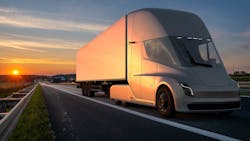The tailwinds for continued commercial battery electric vehicle adoption seem to be picking up. Stirrings of these changes, though, have been brewing for some time.
As the industry accelerates toward the actuality of electric trucks on the road, several companies in the commercial vehicle space have begun to more readily announce new products, renewed initiatives, and restructured teams to focus on e-mobility and electrification.
The most recent announcement came from Meritor in January, regarding start of full production on the 14Xe fully electric powertrain in mid-2021.
The 14Xe integrates an electric motor and a multi-speed transmission into a differential carrier on the axle. This design eliminates the need for a driveshaft that traditionally transfers power from a diesel engine and transmission to the drive axle. Instead, vehicle batteries supply power to operate the electric motor.
Companies like Dana have also been focused on company acquisitions and bringing electrified component options to fleets. Dana announced in February 2020 full production of its e-S9000r e-Axle for Class 4 and 5 truck and bus applications. The company has also developed a Class 8 e-Axle, which hasn’t yet gone into full production.
As established commercial vehicle suppliers begin to pivot manufacturing to bring these electrified products to market, they bring the knowledge and expertise of understanding the driveline design of traditional diesel trucks in order to take a modular approach developing electrified equivalent designs.
Truck OEs have been hard at work realigning their focus to have a dedicated team focused on electrification and other technology initiatives as well, which includes proprietary electrification product development on the continued path of vertical integration.
Most recently, Daimler revealed plans to invest $20 million in a dedicated Detroit ePowertrain manufacturing facility. That comes after announcing the appointment of Rakesh Aneja to head e-mobility, where he will focus on product strategy, platform management, customer consulting, and charging infrastructure services.
That’s not to mention the Volvo LIGHTs project and launch of the electric VNR in February 2020. That full battery-electric Class 8 goes into full production this year.
Why now?
Advancements in commercial vehicle electrification will continue at a fast clip over the next several years, aided in part by the recommitment of the Biden administration to the Paris Climate Agreement, which looks to have net-zero emissions globally by 2050. Plus, domestic initiatives aim to achieve more aggressive goals as it relates specifically to transportation, with a target of zero-emission heavy-duty vehicles by 2045 in California.
Electrification is coming, and many argue it will come first to commercial vehicles before passenger cars.
The use cases are there, the widespread adoption is not. At least not yet. But, expect big changes in the coming decade.
“When it comes to electrification, we’re talking about the next couple of years across the industry, sales will be in the hundreds. I don’t think you’re going to see a transition to sales in the thousands until 2023, and then 2024 is really when you’ll start to see a significant gain—maybe in 2024, the industry will start selling 10,000 units a year,” Peterbilt General Manager and Paccar Vice President Jason Skoog told FleetOwner.
The regulations designed to further reduce vehicle emissions will help bring costs down due to greater scale, noted Skoog. Additionally, an incentive to adopt electric technology and a comprehensive national charging infrastructure for commercial vehicles could further drive adoption.
“You’re going to see a convergence of things where maybe an electric vehicle is still more expensive at that time, but when you do a TCO or an ROI calculation, electric can make more sense as we proceed throughout the decade,” Skoog said.
Suppliers and manufacturers are at the ready and are having those conversations currently with customers. It’s now up to fleets to start more widely exploring the viability of electrification.
About the Author
Erica Schueller
Editorial Director | Commercial Vehicle Group
Erica Schueller is a former editorial director of the Endeavor Commercial Vehicle Group.

